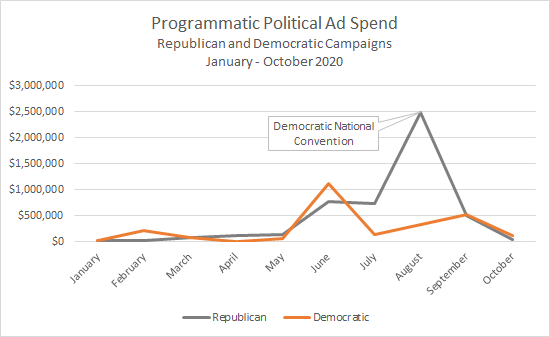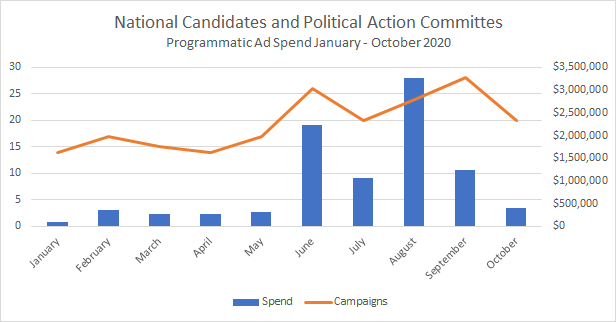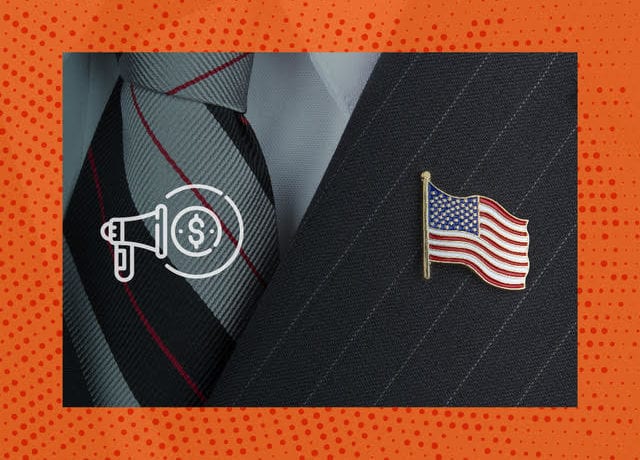2020 has been a stressful election year, characterized by nationwide protests and a global pandemic. In a season of “unprecedented times,” programmatic advertising played a key part in targeting voters during the presidential race.
How much did Republican and Democratic campaigns spend using programmatic this year?
We encourage you to subscribe to our blog for the latest data surrounding the advertising industry. We will provide daily updates as COVID-19 continues to make its mark on the US economy.

Programmatic is Criticized But Carries On
Experts expect the 2020 presidential election to see more than $10 billion spent on political ads. But candidates aren’t spending blindly—they want to use their money to get the biggest bang for their buck.
Programmatic advertising is often the simplest solution: get your message to those who most need to hear it, and don’t waste money on votes you already have or have no chance of acquiring.
But the methods that make programmatic advertising so effective are often criticized. Donald Trump’s campaign admitted to using data such as geographic location and wealth in targeted ads back in 2016. Some argue that the use of programmatic in a political context is too manipulative, and controls an audience rather than informing them.
At the same time, digital advertising channels have enjoyed relative freedom from regulations in the past. The majority of limits, especially for political ads, were specific to television or radio. As programmatic and other digital ads become more widespread, they’ll likely become more legislated. 2020’s use of digital advertising will become a basis for future laws.
While future regulations may not discourage politicians from using digital advertising to their advantage, it does mean that they may have to do so differently. For instance, candidates and PACs may have to learn how to center campaigns on messages applicable to all audience members (instead of just specific targets) and the platforms themselves will have to regulate pricing and distribution.
Online Platforms Take Action to Protect Elections
After Russian interference in 2016, Facebook spent four years trying to ensure that that wouldn’t happen again, aided by security and “integrity” divisions responsible for halting such problems.
“We believe that we have done more than any other company over the past four years to help secure the integrity of elections,” says Guy Rosen, president of integrity.
His department has been responsible for some big changes. Chief among them are the platform’s decision to suspend new ads the week before election day, and the decision to halt all political ads after the election until they have confirmed the winner.
Facebook isn’t the first platform to make such decisions though.
Google also vowed to stop political ads until finalized results are announced, citing the same sensitive-events policy that caused them to stop COVID-related ads back in March. They’re joined by Twitter, whose bans on political ads don’t have a time limit.
MediaRadar Insights
Methodology
We looked at all programmatic ad placements in the political action committees, political candidates, and political fundraising category from January through October.
We excluded all regional ads and all campaigns running on a state or local level—these numbers reflect only ads run by national candidates.
Findings
The total amount spent on programmatic advertisements from January through October is $9.5 million across an average of 20 campaigns.

For January to March, this included one Republican national campaign and three Democratic national campaigns.
The Biden for President campaign started their programmatic ad campaign in May. They spent at least $59 thousand per month, peaking in June with spend hitting $1.1 million. This extra spend can be explained by the twelve Democratic primaries that occurred that month.
The Donald J. Trump for President campaign has consistently run a programmatic ad campaign since January, spending at least $20 thousand per month. In August, they spent $2.5 million in programmatic ads—correlating with the month in which both parties hosted national conventions.
It does appear that October’s programmatic spend is significantly lower, but spend tends to be weighted in the last half of the month. This data does not include spend during the last week of October. However, estimates based on July, August, and September’s upward trends show that spend is likely to increase again in October.

As the final numbers continue to pour in from the election, check back here to see how advertisers and ad hosting platforms are responding to this year’s political scene.
For more updates like this, stay tuned. Subscribe to our blog for more updates on coronavirus and its mark on the economy.



